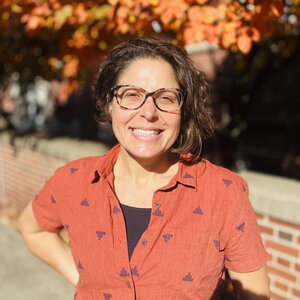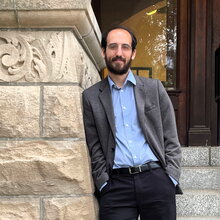The sun supplies a massive amount of energy, generating more in just two days than all of earth’s recoverable oil resources, but to harness more of that solar power, more efficient ways are needed to convert photons into other forms of energy.
Researchers in the lab of Illinois chemistry Prof. Lisa Olshansky have been working on mimicking how biological systems convert one type of energy into another form. Plants, for example, convert the solar energy of the sun into chemical energy.
In a recent project, Olshansky led researchers in the creation of copper molecules that can transfer electrons faster than any other copper molecules ever reported, by at least an order of magnitude faster, according to Olshansky, who was corresponding author with Paul J. Griffin (PhD, '23), former chemistry graduate student and author, on a paper published in JACS that lays out their findings.
“I did not expect these things to be so fast,” Olshansky said of the surprising and exciting results.
Electron transfer (ET) is a vital process in energy conversion, and finding faster, more efficient ways to transfer electrons between synthetically made molecules could lead to more efficient energy conversion technology, like solar panels.
Olshansky said the only mononuclear copper molecules that can do electron transfer faster than their copper molecules are nature-made proteins, called blue copper proteins, which can be found in bacteria and plants.
“And they do really fast electron transfer, but no one has ever been able to make molecules that do electron transfer as fast as these blue copper proteins,” said Olshansky.
The team’s primary goal when this research project began was to make molecules that mimic biological enzyme active sites, or catalytic sites, where a catalyst, like copper, accelerates a chemical reaction in biomolecules. Many biological systems have catalytic sites that change their structural arrangement -- known as dynamicity – during a chemical reaction, and Olshansky’s team was trying to make synthetic catalytic copper models that exhibit dynamicity.
“So, we did that, we achieved that goal, and what we found is these emergent properties, or unexpected properties, that arose as a result of this dynamicity,” said Olshansky, referring to their fast ET rates. She and her team went ahead and published a paper about their rigorous exploration of the dynamicity of their copper complexes in Dalton Transactions, and then reported their unexpected emergent properties in a second paper in JACS.
But, Olshansky explained, what is most surprising about their unexpected findings is that the superfast ET exhibited by their dynamic copper molecules seems in opposition to a very fundamental hypothesis in the field of bioinorganic chemistry that blue copper proteins do fast electron transfer because they are rigid, not dynamic.
“The hypothesis is based on rigidity,” Olshansky said, explaining that rigidity means the blue copper proteins hold one structural arrangement during ET. “But people have made hundreds of rigid models and none of them have ever come close to the electron transfer rates of the blue copper proteins.”
The dynamic copper molecular structures made in the Olshansky lab are the only ones that can match the ET rate of the natural ones.
“So, we suggest in this paper that it calls into question the hypothesis that blue copper proteins work so well because of rigidity,” Olshansky said. “It’s a big result in the field in terms of our understanding of how these biological systems work.”
Griffin said it is very interesting to consider why blue copper proteins were considered rigid in the first place - what's the history behind the idea?
"The structural techniques commonly employed in bioinorganic chemistry suggest a rigid geometry, but these techniques are generally agnostic to small-scale dynamicity in a protein environment. Our work suggests that this small-scale dynamicity - described for a molecular system - may be essential for rapid electron transfer with copper," Griffin explained.
Now, the Olshansky lab is moving forward with projects testing the application of their copper complexes in solar energy conversion.
“The copper complex is a redox mediator, meaning it will shuttle electrons in a solar cell, and because it can do it so quickly, it will be more efficient,” Olshansky said.
Her lab is now collaborating with experts in dye-sensitized solar cells, which are thin film solar cells that use photoelectrochemical technology, to test their copper molecules in that platform.
“And we think it will be way more efficient,” Olshansky said.
And in another project, Olshansky said they are attaching these copper complexes to a fluorophore, another molecule that can absorb light, to make their own molecular solar cell to try and generate light driven charge separated states.
If you shine light on some molecules, Olshansky explained, you get a separation of electron from hole, so a positive charge and a negative charge that naturally want to recombine. And that can happen very quickly. But if the two can be separated for long enough, the electron can be used for a chemical reaction, basically converting that solar energy to chemical energy.
“So, because these copper complexes have multiple structural states, or dynamicity, we think we can leverage that to keep the charges apart for long enough to do the chemical reaction, and basically convert solar energy into fuel. That’s what’s next,” Olshansky said.
Olshansky is an assistant professor of chemistry, LEAP Scholar, and affiliate in the Center for Biophysics and Quantitative Biology, and the Materials Research Lab at Illinois.
This research was supported by the U. S. Department of Energy, Office of Science, Basic Energy Sciences.
Editor’s note:
To contact Lisa Olshansky: lolshans@illinois.edu
The paper “Conformational dynamicity in a copper(ii) coordination complex” is available online. DOI: 10.1039/d3dt01213a
And the paper “Rapid Electron Transfer Self-Exchange in Conformationally Dynamic Copper Coordination Complexes” is available online. DOI: 10.1021/jacs.3c05935


